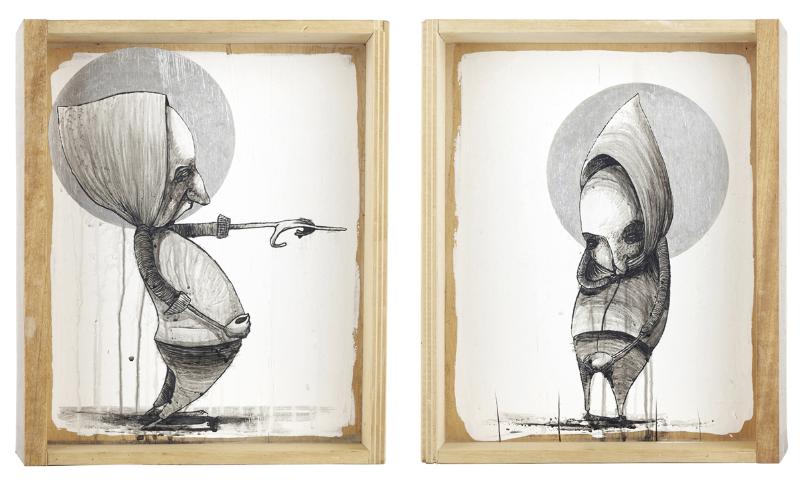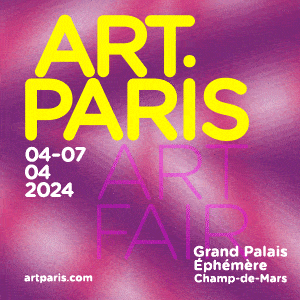Whitehot Magazine
April 2024
"The Best Art In The World"
"The Best Art In The World"
April 2024
July 2008, Chris Osburn Interviews Stormie Mills

Stormie Mills, Fuckhead, Diptych, mixed media on found object, December 2007, 420mm x 720mm x 125mm
Recent participation in the Burning Bridges summer group show in London, along with the likes of other international heavyweights such as Herakut and local wonder Sweet Toof, provided an excellent opportunity to sit down for an interview with Australian street artist Stormie Mills. In this interview, Stormie - whose work has appeared on the streets and gallery walls throughout the world as well as part of the 2004 Olympics in Athens, Greece – speaks frankly about his path as an artist and offers some advice to the up-and-comers.
For more information visit www.burningbridges.co.uk and www.stormie.com.au
How and why did you get into street art?
I came through the same as most people learning to use spray-paint, dealing with scale, being a graffiti writer, experimenting in the street in 1984. It was after seeing album covers, music videos and movies that had NYC graffiti as a backdrop. Then in 1986 I went to NYC and met graffiti writers like Beam TC5 and Doze Green. I was also exposed to all the action that was going on in the streets with interventionist art and the end of the era of trains being painted and run. One of the things I found most incredible was a book called Street Art by Craig Castleman. That had Futura's "break" whole car and walls by A-One etc but also amazing things like John Fekner, Keith Haring and Jenny Holzer's series of Inflammatory Essays; it opened my mind to all kinds of art that was being placed in public areas.
What was the move from street artist to pro like for you? When you first started painting on the streets did you hope to get recognition, show in galleries and work on paid projects?
I was never too secretive about what I was doing, not really trying to hide it. In a small city with few people doing graffiti at the start it was pointless. Everyone knew. Then I started focusing my attention on characters, as I'd drawn people and figures since I can remember, that at the time characters were only really ornamentation for pieces, but gradually I became increasingly interested in characters/figures and the examination of the human condition, isolation loss and regret. So people started to ask me to paint things for them, walls etc, and I was always hungry to paint so I asked for spots, travelled and made art if it wasn't walls it was canvas, paper or whatever I could get hold of, so then I began organising shows and putting things together, always pursuing the creative process. Then in 1997, I made a conscious decision to work on my first solo show and was given a spot at an artist-run space in Perth called JackSue Gallery. The show was successful, and many people wanted my canvases and I kept going. This lead to being signed to LK Galleries in Perth West Australia and then to working with Richard Martin in Sydney. I never started any of this as a career decision. It wasn't a career choice; it was part of me, my voice, what I do and something I couldn't give up even if I tried. This obsession led to refining what I do and to people wanting to commission me and collecting my work.
How did you commission to paint large scale murals for the Greece Olympics come about. Have any thoughts about the upcoming Olympics in Beijing and London?
Susan from ArtCrimes emailed me and told me to email Woozy about a project he was working on and then I was on the A Team and went to Greece travelling as a group painting every day in many places. An amazing group of people implementing Woozy's vision for huge walls all over the country.
Word is you failed out of art school? What happened? Did you have any serious doubt about your talent at that time or? How did you manage to persevere?
Well not entirely, I went to about 8 or 9 schools as a kid, in one of them I was failed at art class. It was more a case of the teachers not really understanding what I was doing. It wasn't a movement or contemporary art form at that time, so perhaps a case of too strange to quantify within an educational institution, very different to now. I was accepted once into another Art College in the UK but I lasted two weeks before bills and rent built up and I knew I'd have to get a job. I still have doubt about myself and what I do, and how I do it etc; it's perhaps what drives me more than anything. I just keep moving forward learning from what I do and my mistakes. That to me is one of the strengths of being a graffiti writer: it's a movement of artwork created in adverse conditions. It makes me think of what I'm doing rather than just doing. For me, it's one of the main reasons I like to keep a restricted palate, like I started with. I also have an amazing support system of friends and most importantly, Melissa, who believes in me often it seems more than I do myself.
Got any advice for up-and-coming graf artists?
Tenacity, humility and belief in the creative process. Think about what you do and make it your own. Following a small component of what you do with the materials you have available may well become a significant component of your work rather than just a nuance. Work hard. It's got to be an obsession, a driving passion. A friend Reg Bolton told me, when I was having a major crisis of direction and confidence, "love what you do, do what you love, the money will follow" for me that's been good advice.

Chris Osburn
Chris Osburn is an American transplant living in London where he has a blast working as a freelance photographer, writer, consultant, blogger and more. www.tikichris.com











